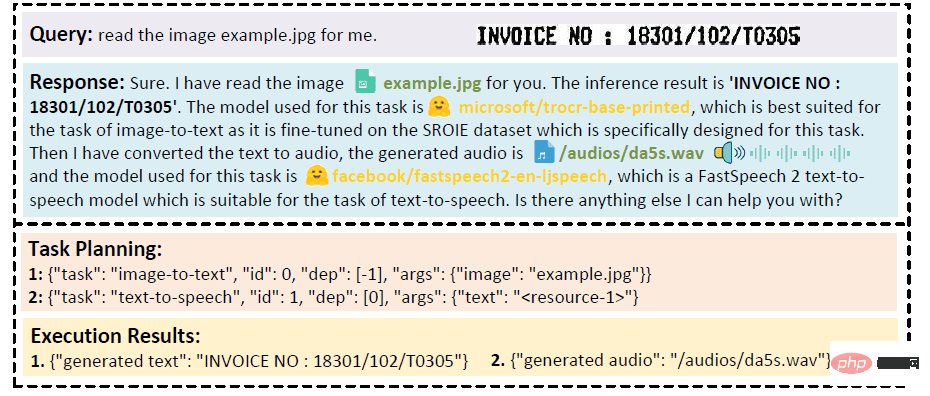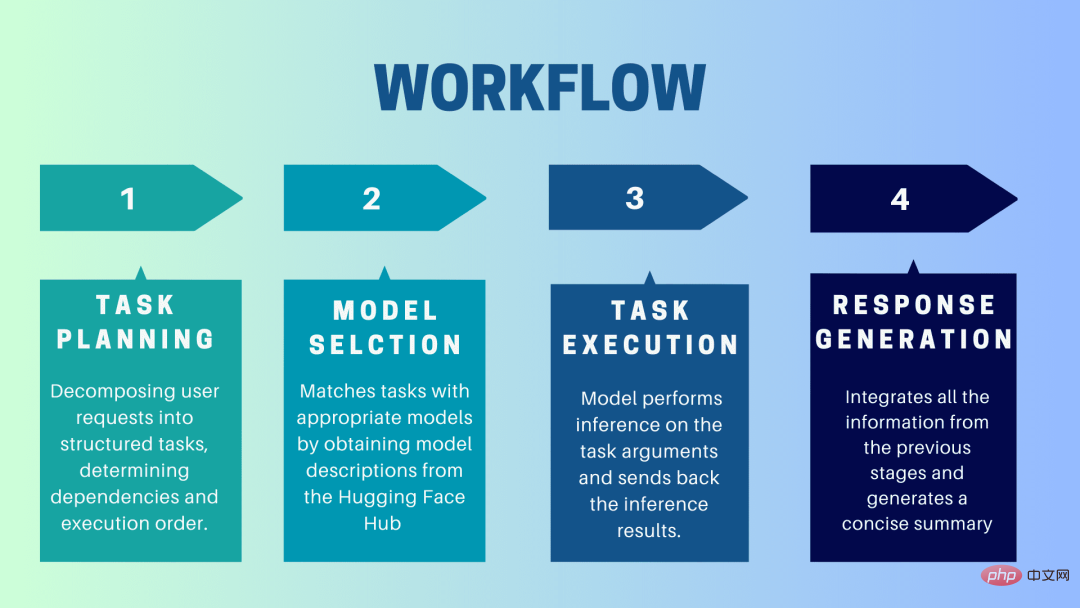Home >Technology peripherals >AI >HuggingGPT: A magical tool for AI tasks
HuggingGPT: A magical tool for AI tasks
- WBOYWBOYWBOYWBOYWBOYWBOYWBOYWBOYWBOYWBOYWBOYWBOYWBforward
- 2023-05-08 18:40:191564browse
Introduction
Artificial General Intelligence (AGI) can be thought of as an artificial intelligence system that is capable of understanding, processing, and responding to intellectual tasks like humans. This is a challenging task that requires a deep understanding of how the human brain works so that we can replicate it. However, the emergence of ChatGPT has aroused huge interest from the research community in developing such systems. Microsoft has released such a key AI-powered system called HuggingGPT (Microsoft Jarvis).
Before we dive into what’s new in HuggingGPT and the relevant details on how it works, let’s first understand the issues with ChatGPT and why it has trouble solving complex AI tasks. Large language models like ChatGPT are good at interpreting text data and handling general tasks. However, they often struggle with certain tasks and can react absurdly. You may have encountered fake responses from ChatGPT while solving complex math problems. On the other hand, we have expert-level AI models such as Stable Diffusion and DALL-E, which have a deeper understanding of their respective subject areas but struggle with a wider range of tasks. Unless we establish a connection between LLM and professional AI models, we cannot fully exploit the potential of LLM to solve challenging AI tasks. This is what HuggingGPT does, it combines the advantages of both to create a more effective, accurate, and versatile AI system.
What is HuggingGPT?
According to a recent paper published by Microsoft, HuggingGPT leverages the power of LLM, using it as a controller to connect it with various AI models in the machine learning community (HuggingFace), enabling it to be used External tools to increase productivity. HuggingFace is a website that provides a wealth of tools and resources for developers and researchers. It also has a wide variety of professional and high-precision models. HuggingGPT applies these models to complex AI tasks in different domains and modes, achieving impressive results. It has similar multi-modal capabilities as OPenAI GPT-4 when it comes to text and images. However, it also connects you to the Internet, and you can provide an external web link to ask questions about it.
Suppose you want the model to perform an audio reading of text written on an image. HuggingGPT will perform this task serially using the best-fitting model. First, it will export text from the image and use the result for audio generation. The response details can be viewed in the image below. Simply amazing!

Qualitative Analysis of Multimodal Cooperation of Video and Audio Modes
How does HuggingGPT work?

HuggingGPT is a collaborative system that uses LLM as an interface to send user requests to expert models. The complete process from user prompt to model until response is received can be broken down into the following discrete steps:
1. Task planning
At this stage, HuggingGPT uses ChatGPT to understand the user prompt, Then break the query into small actionable tasks. It also identifies the dependencies of these tasks and defines the order in which they are executed. HuggingGPT has four slots for task parsing, namely task type, task ID, task dependency and task parameters. Chats between HuggingGPT and the user are recorded and displayed on the screen showing the resource history.
2. Model selection
Based on the user environment and available models, HuggingGPT uses a contextual task-model allocation mechanism to select the most appropriate model for a specific task. According to this mechanism, model selection is considered as a multiple-choice question, which initially filters out models based on the type of task. Afterwards, the models were ranked based on the number of downloads, as it is considered a reliable measure of model quality. Top-K models are selected based on this ranking. K here is just a constant that reflects the number of models, for example, if it is set to 3, then it will select the 3 models with the most downloads.
3.Task Execution
Here, the task is assigned to a specific model, which performs inference on it and returns the results. To make this process more efficient, HuggingGPT can run different models simultaneously, as long as they don't require the same resources. For example, if given a prompt to generate pictures of cats and dogs, different models can be run in parallel to perform this task. However, sometimes a model may require the same resource, which is why HuggingGPT maintains a
4. Generate response
The last step is to generate a response to the user. First, it integrates all information and reasoning results from previous stages. The information is presented in a structured format. For example, if the prompt is to detect the number of lions in an image, it will draw appropriate bounding boxes with detection probabilities. LLM (ChatGPT) then takes this format and renders it in human-friendly language.
Set up HuggingGPT
HuggingGPT is built on Hugging Face’s state-of-the-art GPT-3.5 architecture, which is a deep neural network model that can generate natural language text. Here are the steps on how to set it up on your local machine:
System Requirements
The default configuration requires Ubuntu 16.04 LTS, at least 24GB of VRAM, at least 12GB (minimum), 16GB (standard), or 80GB (full) RAM, and at least 284GB of disk space. Additionally, 42GB of space is required for damo-vilab/text-to-video-ms-1.7b, 126GB for ControlNet, 66GB for stable-diffusion-v1-5, and 50GB for other resources. For "lite" configuration, only Ubuntu 16.04 LTS is required.
Steps to get started
First, replace the OpenAI Key and Hugging Face Token in the server/configs/config.default.yaml file with your keys. Or, you can put them in the environment variables OPENAI_API_KEY and HUGGINGFACE_ACCESS_TOKEN respectively
Run the following command:
For Server:
- Set up the Python environment and install the required dependencies.
<code># 设置环境cd serverconda create -n jarvis pythnotallow=3.8conda activate jarvisconda install pytorch torchvision torchaudio pytorch-cuda=11.7 -c pytorch -c nvidiapip install -r requirements.txt</code>
- Download the required model.
<code># 下载模型。确保`git-lfs`已经安装。cd modelsbash download.sh # required when `inference_mode` is `local` or `hybrid`.</code>
- Running Server
<code># 运行服务器cd ..python models_server.py --config configs/config.default.yaml # required when `inference_mode` is `local` or `hybrid`python awesome_chat.py --config configs/config.default.yaml --mode server # for text-davinci-003</code>
Now you can access Jarvis's service by sending an HTTP request to the Web API endpoint. Send a request to:
- /hugginggpt endpoint and use the POST method to access the complete service.
- /tasks endpoint, use the POST method to access the intermediate results of phase 1.
- /results endpoint, use the POST method to access the intermediate results of stages 1-3.
These requests should be in JSON format and should include a list of information entered on behalf of the user.
For Web:
- After launching the application awesome_chat.py in server mode, install node js and npm on your computer.
- Navigate to the web directory and install the following dependencies:
<code>cd webnpm installnpm run dev</code>
- Set http://{LAN_IP_of_the_server}:{port}/ to web/src/config/ HUGGINGGPT_BASE_URL for index.ts, in case you are running the web client on another machine.
- If you want to use the video generation function, please compile ffmpeg manually using H.264.
<code># 可选:安装 ffmpeg# 这个命令需要在没有错误的情况下执行。LD_LIBRARY_PATH=/usr/local/lib /usr/local/bin/ffmpeg -i input.mp4 -vcodec libx264 output.mp4</code>
- Double-click the settings icon to switch back to ChatGPT.
For CLI:
Setting up Jarvis using the CLI is very simple. Just run the below mentioned command:
<code>cd serverpython awesome_chat.py --config configs/config.default.yaml --mode cli</code>
For Gradio:
Gradio demo is also hosted on Hugging Face Space. You can experiment after entering OPENAI_API_KEY and HUGGINGFACE_ACCESS_TOKEN.
To run it locally:
- Install the required dependencies, clone the project repository from Hugging Face Space, and navigate to the project directory
- Use the following Command to start the model server and then start the Gradio demo:
<code>python models_server.py --config configs/config.gradio.yamlpython run_gradio_demo.py --config configs/config.gradio.yaml</code>
- Access the demo via http://localhost:7860 in your browser and test it by entering various inputs
- As an option, you can also run the demo as a Docker image by running the following command:
<code>docker run -it -p 7860:7860 --platform=linux/amd64 registry.hf.space/microsoft-hugginggpt:latest python app.py</code>
Note: If you have any questions, please refer to the official Github Repo (https://github. com/microsoft/JARVIS).
Final Thoughts
HuggingGPT also has certain limitations that need to be emphasized here. For example, the efficiency of the system is a major bottleneck, and HuggingGPT requires multiple interactions with LLM at all stages mentioned earlier. These interactions can result in degraded user experience and increased latency. Likewise, the maximum context length is limited by the number of tokens allowed. Another issue is the reliability of the system, as LLM may misinterpret prompts and produce a wrong task sequence, which in turn affects the entire process. Nonetheless, it has great potential for solving complex AI tasks and is a good advancement for AGI. Let’s look forward to the direction this research will take the future of AI!
The above is the detailed content of HuggingGPT: A magical tool for AI tasks. For more information, please follow other related articles on the PHP Chinese website!
Related articles
See more- Technology trends to watch in 2023
- How Artificial Intelligence is Bringing New Everyday Work to Data Center Teams
- Can artificial intelligence or automation solve the problem of low energy efficiency in buildings?
- OpenAI co-founder interviewed by Huang Renxun: GPT-4's reasoning capabilities have not yet reached expectations
- Microsoft's Bing surpasses Google in search traffic thanks to OpenAI technology

